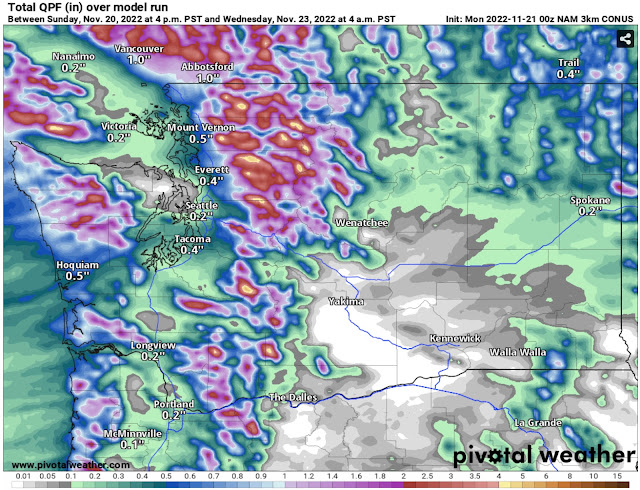No FastCast tonight, but keep reading below for an update on the system currently moving through the region. Snow is in the beginning of the post, with very cold temperatures at the end.
------------------------------------------------------------
It has been a very interesting past 24 hours across the Puget Sound region. Overnight, 4-8 inches of snow fell from North Seattle to Marysville, with 6-12 inches near Hood Canal and in the Cascade foothills. 18-24 inches fell in the mountains, prompting a closure on Snoqualmie Pass.
On Wednesday afternoon, snow started in areas south of Seattle and in the foothills, accumulating 0.5-2.25 inches by 9 PM, when snow tapered. Let's take a look at the upcoming forecast.
Below is the European model forecast for low temperatures overnight Wednesday into Thursday morning.
I started with this because any water on the roads across the region will likely freeze, except on busier roads like highways. Lows are expected to be in the mid to upper 20s, except in the low 30s near the water. Lows in the low 20s are possible in Whatcom County, coupled with very cold wind chills in the upper single digits to mid teens. In Eastern Washington, expect lows in the mid teens to mid 20s, except warmer in the lower Columbia Basin.
Now for the snow forecast. It is important to know that forecast models have been having a hard time accurately forecasting snow with this system, so any solutions below are merely a possibility, and not an actual forecast.
So, with that being said, let's look at what's possible overnight, starting with the NAM forecast through 5 PM Thursday.
The NAM forecast is the most ambitious, showing 2-6 inches of snow in the foothills and from Centralia to Seatac.
Next is the HRRR forecast, also showing snow through 5 PM Thursday.
This forecast is much less optimistic for snow, showing 0.5-1 inches from Seattle south to Portland, with more (1-2 inches) in the foothills and near Kelso/Longview.
Finally, let's take a look at the European model, showing snow through 4 PM Thursday.
The European model is a middle ground between the NAM and HRRR. This shows 0.5-3 inches of snow from Everett southward, with the most in the Cascade foothills and near Kelso/Longview and the North/Central Coast.
So, to summarize, another band of snow will potentially impact the region from late Wednesday night through Thursday morning. Uncertainty remains on the placement of this band and how much snow will accumulate, but 1-3 inches south of Seattle (most in the foothills) is a good guess.
Additionally, Thursday will not be very warm, so any snow remaining won't melt too much. The European model's Thursday highs are below.
Highs in the lowlands will only reach the mid 30s, and won't get out of the low 30s in Whatcom County and most of Eastern Washington, except the lower Columbia Basin.
Then, the real cold sets in on Thursday night into Friday morning. The European model's forecast for Friday morning lows is below.
Wow! The European model forecasts lows in the low to mid 20s across the entirety of the lowlands, and potentially in the upper teens for the foothills and Whatcom County. Parts of Eastern Washington will be in the single digits to low teens. Stay tuned for much more information on these very cold temperatures.
In conclusion, the winterlike pattern will continue across Washington State. Stay tuned to Twitter, NWS Seattle, local news, and the blog for updates!


















































